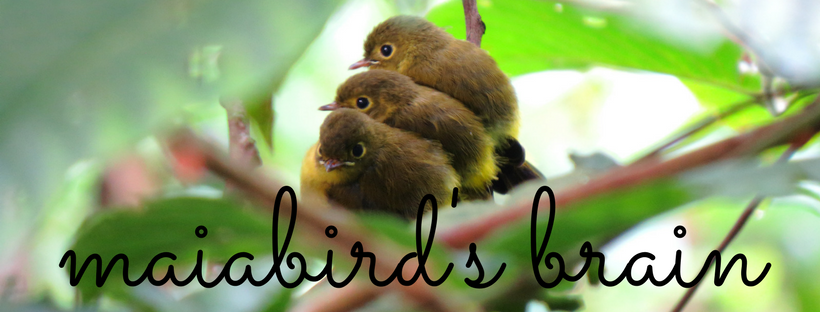Surprisingly, there weren't many people yet and it was a nice quiet walk to the trail and we even saw a White-eared Brown Dove called loudly from a fruiting ficus tree just before the orchidarium. I wasn't able to see that up close but got to see a second one land and disappear into the leaves.
We approached the trail from the right side and saw a Barred Rail walking along the path. We followed it quietly but were distracted by the loud calls of some Grey-backed Tailorbirds. We tracked the skittish birds until one of them finally went out from the brush long enough for a decent photograph (well, decent based on my standards =P)
 |
| This friendly Grey-backed Tailorbird gave me a decent photo and let me view it through my camera's LCD =) |
A male Olive-backed Sunbird started calling loudly from the heliconias along the edge of a clearing and entertained us while it fed on the flower's nectar. It stayed quite a while, diverting our attention from the tailorbirds that stayed almost hidden in the brush.
 |
| Male Olive-backed Sunbird balancing on a heliconia flower |
And then a black bird perched on a low branch near us... could it be the elusive Philippine Drongo Cuckoo?! It was! I focused my camera on the bird and took a shot. I was pleased to get a good enough view through my camera but the photo of my lifer was headless though =P
 |
| My "headless" lifer for the day: Philippine Drongo Cuckoo |
The bird flew around us, picking up a small worm along the way before disappearing into the tall trees. We refocused on the tailorbirds but we heard a very loud, metallic-sounding call. Then lots of Black-naped Orioles started sounding out their alarm calls very noisily. All the ruckus seemed to come from the top of the hill beside us. For some reason, I was able to spot a silhouette of a large bird perched atop an acacia tree. A raptor! Jops and I tried our best to find a good vantage point to better see the raptor and these are the best shots I got:
 |
| The long neck and pale eye was very evident |
 |
| Got some help from friends and identified this as an Oriental Honey Buzzard |
The huge raptor flew down the other side of the hill after quite a few minutes looking around its perch and being swooped in on by agitated orioles. Jops and I finally got to enter the trail after spending an hour in just one area (and got a lifer too!) The effects of the heavy rains of the past week were quite evident, leaving muddy patches here and there and empty "streams" where flood waters flowed.
We kept an eye out for the pittas but found none. We checked on the nest of the Ashy Ground Thrush and saw two chicks peeping out. A lone adult thrush was seen foraging nearby.
 |
| We were happy to see that the nest survived the strong rains |
We left the nest and rounded the trail. I lagged behind a bit when I thought I heard some scratching on the ground when I saw Jops gesturing urgently at me. I hurried to where he was standing and he pointed out an orange bird, flitting from perch to perch. The Rufous Paradise Flycatcher! It was back! I finally got to see it in LMEP!
 |
| As a bonus, I got a documentary shot of the Rufous Paradise Flycatcher! |
It flitted deeper into the trees and was soon out of sight. We waited a bit but the bird didn't come back to the area. We rounded the trail, shushing some very noisy park goers along they way. We didn't find any additional birds and since it was nearing noon, decided it was time to go.
Birding without my binoculars wasn't as bad as I expected but I did want to see the birds up close through them. Jops very generously would lend me his whenever we saw birds but I didn't want to deprive him good views because of my forgetfulness. I hope I don't forget them again as I don't want to go birding "blind" again!










